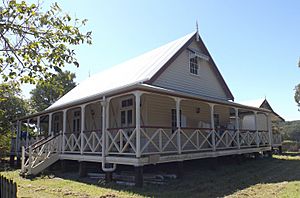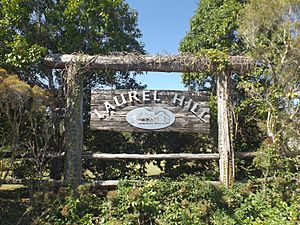Laurel Hill Farmhouse facts for kids
Quick facts for kids Laurel Hill Farmhouse |
|
|---|---|

Farmhouse in 2015
|
|
| Location | 105 Ruffles Road, Willow Vale, City of Gold Coast, Queensland, Australia |
| Design period | 1870s - 1890s (late 19th century) |
| Built | 1883 - 1884 |
| Built for | William Doherty |
| Official name: Laurel Hill Farmhouse | |
| Type | state heritage (built) |
| Designated | 1 December 1997 |
| Reference no. | 601936 |
| Significant period | 1880s-1920s (fabric) 1880s-1940s, 1897 (historical) |
| Significant components | trees/plantings, kitchen/kitchen house, garden/grounds, farmhouse |
| Builders | Alexander Fortune |
| Lua error in Module:Location_map at line 420: attempt to index field 'wikibase' (a nil value). | |
Laurel Hill Farmhouse is an old farm house in Willow Vale, Queensland, Australia. It is listed on the Queensland Heritage Register, which means it is protected because of its important history. The house was built between 1883 and 1884 for a farmer named William Doherty. The builder was Alexander Fortune.
Contents
History of Laurel Hill Farmhouse
Laurel Hill Farmhouse is a wooden farm house with an attic. It was built for William Doherty, who grew and made arrowroot in the Pimpama area. At the time, people thought Laurel Hill Farmhouse was one of the nicest homes in the Pimpama district. In 1897, the Queensland Lands Department even took a picture of it to show what a successful farmer's home looked like.
Early Days in Pimpama
In the 1850s, a lot of land in the Pimpama area was used for large cattle farms. But in the late 1860s, the government opened up much of this land for smaller farms. This allowed people to "select" (choose and buy) pieces of land. Many Irish settlers came to the area around 1870 and started farming.
Farmers in Pimpama first tried growing cotton, then sugar. However, these crops were difficult to grow. By the late 1870s, many large sugar farms had stopped production. Farmers then looked for a new crop that would do well in the area.
The Rise of Arrowroot Farming
They found that the Pimpama area was perfect for growing and processing arrowroot. Arrowroot is a plant whose roots are used to make a type of starch, similar to cornstarch. It was a good choice because it could handle frost, dry weather, and floods better than other crops.
The Lahey family, who lived next to William Doherty, started growing arrowroot on a large scale. They even invented a new way to process it, which made production much easier. By 1884, arrowroot was a very popular crop in the Pimpama and Coomera areas.
William Doherty and His Farm
William Doherty and his wife, Eliza Fannon, came to Queensland from Ireland. They moved to the Pimpama area around 1870. William worked on different farms before choosing his own land in the mid-1870s.
In 1874, Doherty selected a piece of land on Hotham Creek, where Laurel Hill Farmhouse now stands. There were already some small buildings and cleared land on it. He also selected the land next door. The Doherty family lived on the neighbouring block for a few years before moving to the land where the farmhouse was built.
In 1884, William Doherty officially owned his land, which he named Laurel Hill. He then hired Alexander Fortune, a builder from Coomera, to construct a beautiful new house. This house is the Laurel Hill Farmhouse we see today.
Life and Changes at Laurel Hill
At Laurel Hill, William Doherty raised cattle and grew various crops, especially arrowroot. By 1884, he had a large area dedicated to arrowroot and built his own factory to process it. Parts of this old factory still exist today.
After William Doherty passed away in 1904, his three sons took over the properties. Laurel Hill went to his son, William Alexander (Alex). The family continued to be important members of the local community.
Over the years, some changes were made to the farmhouse. For example, some inside walls were moved, and the stairs to the attic were taken out. The original kitchen building burned down in the late 1920s and was replaced with the kitchen building that is there now.
What Laurel Hill Farmhouse Looks Like
Laurel Hill Farmhouse is a single-storey house made of wood, with a pointy roof made of corrugated iron. It sits on wooden posts and faces Ruffles Road.
The house has porches (called verandahs) on all four sides. At the back, there is a separate kitchen building connected by a covered walkway. The original windows in the attic have been covered with wood.
The porches have metal roofs and wooden posts. Some parts of the porches have fallen apart, and only a few sections of the railing are left. The main entrance has a wooden door with a fanlight (a window above the door). There are also French doors (double doors with glass panes) and sash windows (windows that slide up and down) that open onto the porches.
The kitchen building is made of unpainted wood and has a pointy metal roof. It has sash windows and some windows that open outwards or have adjustable slats.
Inside, the house has a large living area and four bedrooms. The walls and ceilings are unpainted. The attic space is now closed off, and the stairs that once led to it are gone. Some of the inside walls might have been changed over time. The outside walls have wide horizontal wooden boards, while the inside walls have vertical boards.
The kitchen building has unpainted walls and ceilings. It includes a dining area and a bathroom, with the kitchen located in a section at the back.
Around the house, there are overgrown gardens and the remains of a rock garden. There are also many large trees and parts of an old shed.
Why Laurel Hill Farmhouse is Important
Laurel Hill Farmhouse was added to the Queensland Heritage Register in 1997 because it meets several important criteria.
A Look into Queensland's Past
This farmhouse helps us understand the history of Queensland. It shows how important arrowroot farming was in the Pimpama area in the late 1800s and early 1900s. At that time, this region produced almost all the arrowroot used in Australia. Even in 1897, the house was seen as a great example of what a successful farmer could achieve in Queensland.
A Rare Find
It is rare to find a farm house from the early 1880s that is still so complete in the Gold Coast area. This region has seen a lot of new buildings and changes in recent times, making old, intact homes like this very special.
Learning from the Past
The farmhouse can teach us a lot about how wooden buildings were constructed in the early 1880s and what materials were used. The kitchen building, built around the 1920s, is also very well preserved and looks similar to the older building it replaced.
A Typical Settler's Home
Laurel Hill Farmhouse is still mostly in its original condition. It shows us what a typical farmer's house from the early 1880s looked like, with its unpainted inside and original wooden features.
Special Connection to the Community
The local community values Laurel Hill Farmhouse because of its long connection to the Doherty family. The Dohertys were important members of the community and helped build the area. For families whose ancestors were among the first European settlers, this farmhouse is an important link to their past.



